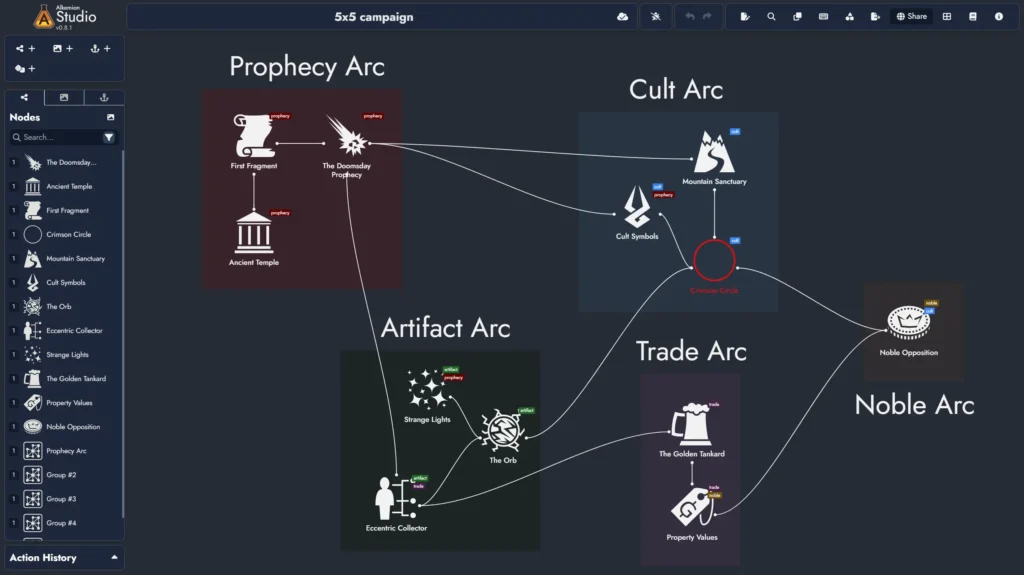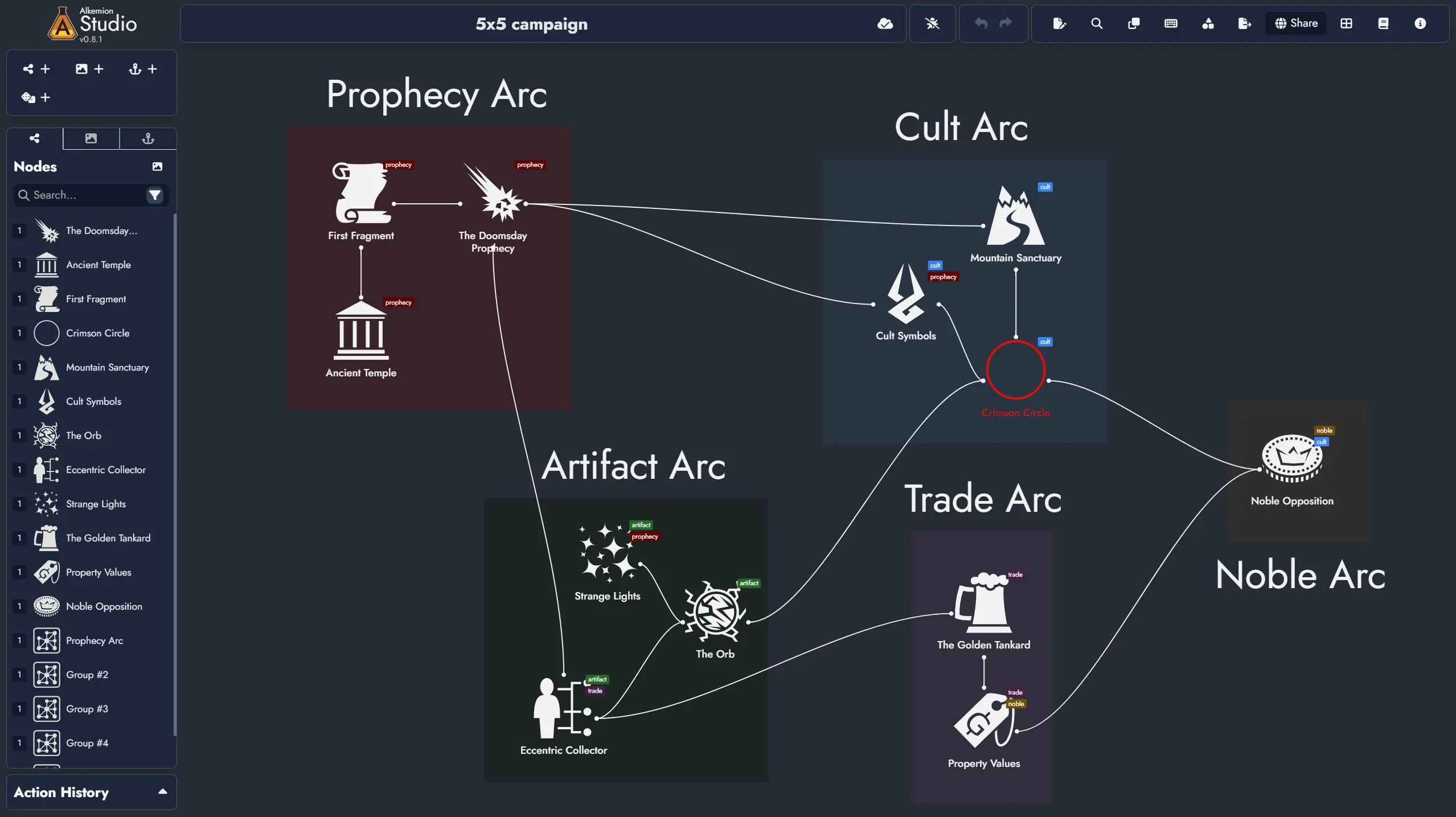There’s something deeply unsettling about the way we run our games. We sit there, behind our screens, pretending we’re master storytellers while frantically improvising as our players demolish hours of careful plotting with a single well-placed Suggestion spell. We chase the dragon of the perfect campaign, that mythical beast where player agency meets coherent narrative, where every choice matters but somehow everything still makes sense.
Finding Order in Chaos
As a software engineer, I’ve always been drawn to frameworks that help structure chaos into something manageable. The 5×5 method is exactly that kind of framework, and it’s been my go-to tool for the past year, turning my sprawling campaign ideas into organized, flexible structures that actually work at the table.
The premise, as developed by Dave Chalker back in 2009, is deceptively simple: take five major plot threads, give each five milestone steps, and connect them through shared locations, recurring NPCs, and overlapping events. What you get is twenty-five story beats that link together, creating a network of possibilities that’s simultaneously vast and manageable. It’s like building a maze where every wrong turn could actually be right, every dead end could lead to somewhere interesting, and all the paths secretly connect through hidden doors and secret passages.
Theory Meets Practice: A Case Study
Let me give you an example from my current campaign: one quest line follows a dark prophecy about the end of days, discovered in fragments across ancient temples. Another deals with a dangerous cult that’s been recruiting in major cities, their symbols matching those in the prophecy’s texts. A third involves tracking down a powerful artifact: an orb that the cult’s leader once possessed, its energy signature matching the strange lights described in the prophecy’s final verses.
When my players raided the cult’s mountain sanctuary, they found prophecy fragments in the leader’s quarters, alongside notes about the artifact’s last known location. Each thread pulls on the others, creating ripples that my players can follow no matter which lead they choose to pursue.

The Power of Flexible Structure
The beauty of the 5×5 method lies in its structured chaos. When your players inevitably decide that instead of investigating the dark prophecy, they’d rather open a tavern and become fantasy real estate moguls, you don’t panic. Because somewhere in your twenty-five interconnected nodes, there’s a thread about cult members scoping out properties in their neighborhood for secret meeting places. The prophecy’s omens start manifesting in their tavern’s cellar. The cult’s activities drive away customers from certain districts, affecting property values. That artifact they ignored? Turns out one of their regular patrons, an eccentric collector, has been researching its connection to the prophecy, and the cult knows this.
Building Your Own Framework
Here’s how you actually do it:
First, write down five problems that are too big to solve with a single fireball (one of the PCs in my campaign is a pyromaniac druid, don’t ask). These are your major quest lines. Make them different enough that they don’t feel like five variations of “kill the bad guy,” but connected enough that they could conceivably exist in the same world. A political conspiracy, an environmental catastrophe, a religious schism, a magical calamity, and yes, maybe one “kill the bad guy” plot for tradition’s sake.
Then, break each of these down into five steps. Each step should feel like the end of a show episode, important enough to be satisfying but open-ended enough to make everyone tune in next week. The trick is to make these steps interconnected. The clue that reveals the conspiracy also hints at the cause of the environmental disaster. The religious zealots are somehow involved in the magical calamity. The bad guy is everybody’s ex.
The Space Between: Where Players Live
The real magic happens in the spaces between these steps. That’s where your players live, in the glorious chaos of possibility. They’re not following your carefully plotted flowchart (at least mine never did, not even once), they’re creating their own story that just happens to intersect with your framework at dramatically satisfying moments.
You obviously don’t have to write twenty-five separate adventures. Instead you create a mesh of consequences and possibilities. When your players do something unexpected (and they will), you don’t have to frantically rewrite everything. You just need to understand how their actions ripple through the mesh.
Embracing Beautiful Lies
The 5×5 method isn’t perfect. Like all tools of our trade, it’s a beautiful lie we tell ourselves to make the chaos manageable. But it’s a useful lie. It gives us enough structure to feel prepared without so much that we become inflexible. It lets us say “yes, and” to our players’ wildest ideas while maintaining a world that feels coherent and alive.
So next time you find yourself staring at a blank page, trying to figure out how to create a campaign that won’t immediately derail when your players decide to adopt the dungeon boss instead of fighting it, try the 5×5 method. Build your own web of possibilities. Then sit back and watch as your players hack their own path through it, creating a story that’s both completely unexpected and somehow exactly what you wished you planned all along.
Just remember: the map is not the territory, the menu is not the meal, and your 5×5 grid is not the campaign. It’s just the framework that helps you fake being the omniscient narrator of a story you’re actually discovering along with everyone else at the table.
And isn’t that the whole point?
If you like this topic, you can find a great selection of links on critical-hits.com, the blog where Dave Chalker published his original post.



Leave a Reply